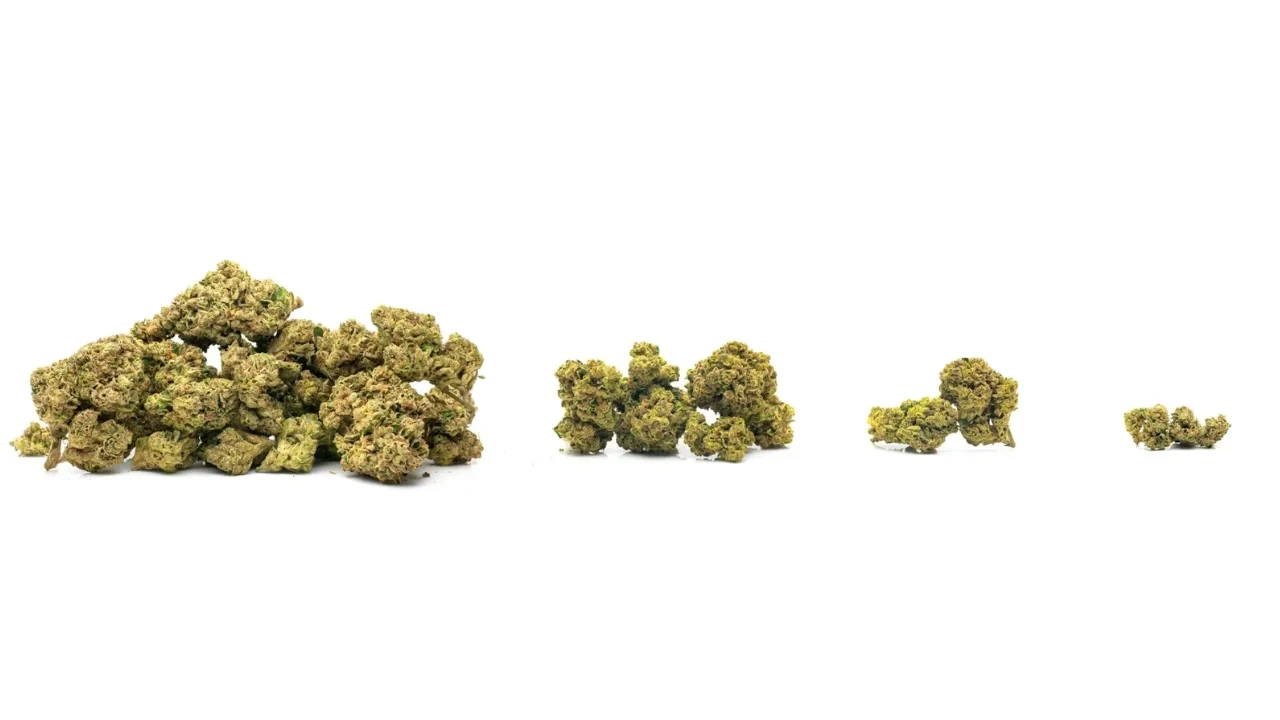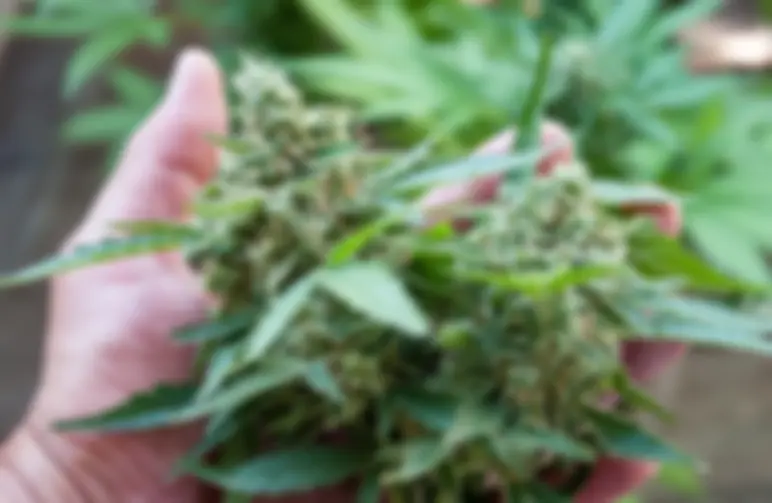Growing your own cannabis plants is not a difficult task, and even first-time growers can achieve a successful yield. Yet the best yields are not just about the quantity but the quality of the buds as well. Many growers prefer big nugs that are covered in thick, sticky resin.
Therefore, if this is something you’d like to achieve, the following guide will show you how to grow dense buds in your own grow room or garden.
Dense buds vs airy buds
Growers tend to prefer plants with dense nugs as they have more mass, look healthier, and are more pleasant to consume. In addition, they are often higher in THC content, as indicated by their thick, sticky coating of resin.
By contrast, airy buds appear weaker, smaller, and flaccid in comparison, and they generally carry less THC.
One of the main factors that decide whether you will get big weed nugs or smaller, airy ones is the plant’s genetics. Seeds with Indica genetics tend to produce thick, dense buds with more resin, while sativa seeds produce airier, looser buds.
This is due to the climates each strain comes from: sativa strains come from warm, tropical regions, and their airy structure protects them from rot and mold. On the other hand, indica strains originate from colder and drier regions, such as mountainsides.
With longer, colder winters and shorter summers, indica plants have developed a faster life cycle as well as a tighter, thicker bud structure.

Big Fat Nugs Indoors and Outdoors: How to Get Dense Buds?
1. Select a Dense Bud strain
Step one to growing dense buds is choosing our dense bud strains, which are known to produce strong, dense buds. Indica dominant strains produce the thickest and densest buds, so if you pick one of those cannabis seeds, you are more include to indeed grow some dense cannabis buds.
To help you out with picking the right strains for very dense buds, we have set up a Top 5 list with the best hard dense bud strains.
Keep in mind that not all Indica-dominant strains will give you dense buds every time, and making sure your indoor and outdoor cannabis plants are given optimal growth conditions is vital to produce buds that are thick and compact.
2. Choose the right pot (size)
The right kind of pot will determine how well your plant grows, and ultimately the size of your buds. Fabric pots, smart pots, and air pots that promote better air circulation will allow the plant to grow stronger roots that reach downwards rather than spreading out.
The size of your pot depends on the size of your growing space, the number of plants you wish to grow, and whether you wish to grow indoors or outdoors.
Small pots between 6.5 and 8.5 liters (1.7 and 2.2 gallons) are best for autoflowering feminized seeds or Sea of Green setups with multiple cannabis plants. Larger pots, up to 25 liters (6.6 gallons), are better for larger plants that need more space to grow. 12 liters (3.1 gallons) is usually considered a good average.
Make sure the pot has enough drainage so that it won’t be drowned by excess water. Keep the pot dark-colored to prevent light from damaging the roots, and make sure it is cleansed of any chemicals or impurities before use. Finally, make sure the pot has enough space to allow roots to grow: the more space, the better.
3. Choose the right growing medium
In order to determine the right growing medium for your plant, you need to make sure the substance allows plenty of room for root growth as well as allowing for consistent access to water, oxygen, and nutrients.
Soil is the most common growing medium, and is natural, easy to use, and usually contains some nutrients already within the soil. Organic potting mixes, especially those with perlite, are the best for cannabis strains as they allow for drainage while retaining oxygen in the soil, promoting faster growth.
Other potential mediums include coco coir, peat moss, rockwool and vermiculite. These act as well as soil, although they do not come with nutrients in the soil, so these must be added with water.
That said, feeding nutrients directly to the roots will promote faster growth than if they are trying to seek it out in the soil.
In addition, these soilless mediums are less susceptible to overwatering or invasive pests like bugs. Another option is to grow your plants hydroponically. This involves growing the roots directly into a solution of nutrient-filled water.
This can produce faster grow times but requires an efficient hydroponic setup to work.
4. Provide proper lightning and reflective Walls (indoors)
In order to grow dense buds, you need to consider not only the amount of lighting the cannabis plant receives but also the type of lighting as well. While having more light allows the plant to grow stronger, too much light could end up overheating your plant, causing heat stress.
If you are growing your plant outdoors, then you only need to make sure it receives eight hours of sunlight a day, with some additional protection such as shade on especially hot days. For indoor growth, however, you need to consider the type of lighting you wish to use.
Two main types of lighting used for growing plants are CFLs and LEDs. CFLs tend to give off less heat so you can keep them relatively close to the plant, while LEDs will produce more heat and should be kept at least 45 cm (18 inch) from the plant to avoid burning it.
Another type of grow light is HPS, which is very efficient in terms of light produced relative to the power used. These types of lights should be kept at a certain distance relative to their size: 20 cm (8 inches) away for 150W bulbs up to 41 cm (16 inches) away for 1000W bulbs.
Another aspect of lighting to consider is reflective walls. These will maximize the amount of lighting in a grow room and are usually made of white plastic or mylar. Stick with an 18/6 light cycle during the vegetative stage and switch it to 12/12 during flowering for best results.
Yellow, orange, and red color frequencies work best on your plant while flowering, as these replicate the colors of autumn. Keep in mind, however, that your plant uses all frequencies of the color spectrum, so choose lighting that enhances these color spectrums rather than using one exclusively.
5. Provide enough space
In order to make sure your plant grows healthy and strong, you need to provide it with plenty of space. With enough space, your plant won’t be overshadowed by any other plants, which will allow it to receive the maximum amount of light from all parts of its structure.
In addition, with more space, your plant will receive better air circulation, helping it to breathe easier and protecting it from the threat of mold or pests.
Make sure each cola is at least several centimeters away from any others in the area. Also, make sure that the leaves and buds of your plant do not share space with any others. Having a large pot will help ensure that your plant remains separate from any others in the area.
6. Provide proper airflow
Without proper airflow, your buds will not become as fat and dense as you would like. One way to ensure all the buds on your plant receive the right amount of airflow is to expose them through defoliation.
Defoliation removes certain leaves on the plant that are covering up these buds. If you are worried about taking too many leaves off, you can also try tucking leaves to expose the bud sites.
Not only will this allow the plant to develop thicker buds, but better ventilation will protect it from mold, diseases, and pests. Bud rot is something you should be wary of when you want to grow super-dense buds.
7. Temperature and humidity
You need to find the optimum balance between temperature and humidity in order to produce the best results. You should keep the ambient temperature for your plant no lower than 20° Celcius (68° Fahrenheit) at night and no higher than 30° C (86° F) during daylight hours.
For best results, keep it between 20 and 25° C (68 and 77° F) during the seedling stage, 22 and 26° C (72 and 78° F) when vegetative, and back to 20-25° C during the flowering stage.
If your plant is outdoors and the temperature exceeds 30° C, try spraying water on the parts of the plant not receiving direct sunlight.
Humidity levels also need to be adjusted for each stage of the plant’s life cycle. For the seedling stage, humidity should be between 65 and 70% for better water absorption, then drop it down to between 40 and 70% during the vegetative stage as the roots will have absorbed plenty of water.
During the flowering stage, a humidity range of between 40 and 50% will encourage the growth of thicker buds covered in sticky resin.
Read our guide for more information on the right temperatures and humidity for weed growth.
8. Nutrients and watering
To achieve the best possible bud density, you need to feed your plant the right amount of nutrients and water. When it comes to growth nutrients, nitrogen works best during the vegetative stage, but you will need to reduce it when the plant reaches its flowering stage.
Phosphorus and potassium will help your nugs become full and dense during this stage.
You can also use blackstrap molasses and amino acids to make the plant stronger and increase the thickness of your buds. Make sure not to overwater your plants: if the growing medium is still wet, leave it until dry and make sure the pot has enough drainage holes.
9. Apply training and pruning
Both pruning and training methods can greatly influence the density of your buds. Low-stress training techniques involve tying back the highest branches so that the rest of the plant can receive more light. You can combine this with pruning any lower branches that will not receive any light.
Another method for training your plant is super cropping. This high-stress training method involves bending back the branches into 90-degree angles, allowing more light to penetrate the plant’s colas and strengthening the plant, leading to denser buds.
To find out more about these techniques, read our guides on Super Cropping and Low Stress Training.
10. Harvest at the right time
Once the flowering stage is near the end, you might be tempted to start harvesting your plant. However, harvesting too early will not give you the best results, and you should let your plant complete the flowering process before harvesting the nugs.
One way to determine when the right time is to harvest is by observing the color of the pistils growing on your plant: once these little hairs turn from white to orange or a reddish-brown color, it is a good sign the buds are ready to harvest.
Another way to determine if the plant is right for harvesting is by observing the trichomes. Take a look through a microscope, and you will notice them go from being clear to milky white, followed by amber color. At this stage, they are ready to be harvested. In addition, the leaves will turn yellow and start to curve. Finally, you should see the buds becoming noticeably denser and ready for taking.
Read our guide about the right time to harvest plants to make sure your timing is even more on point for those lovely dense buds.





